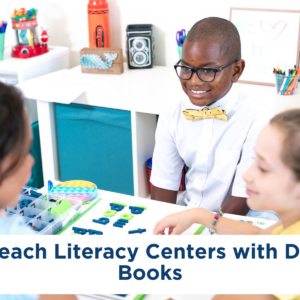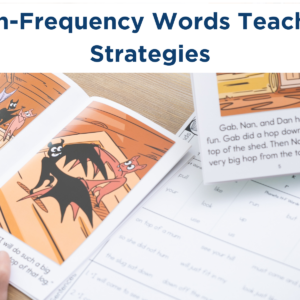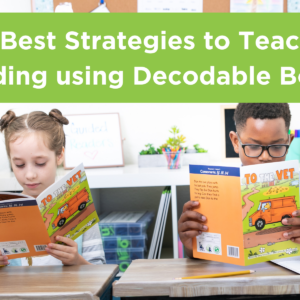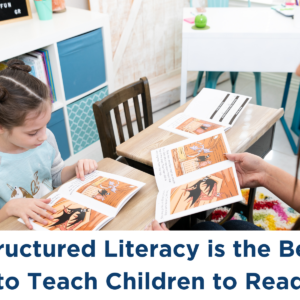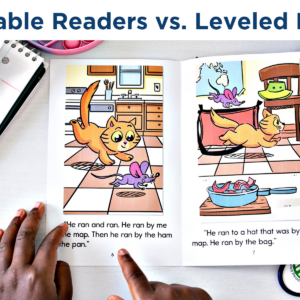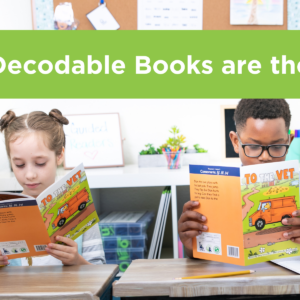Can literacy centers align with the Science of Reading research? I hear this question often, and the answer is a resounding yes! Today, I’m sharing five ways to implement Science of Reading literacy centers using decodable books.
In my opinion, there are a few requirements for successful literacy centers. First, they need to be no or low prep. You shouldn’t have to spend three hours planning every week to change your centers and activities. That’s not sustainable for you as a teacher.
Second, literacy centers need to be easy to implement. It’s really important that students can independently do the activities without distracting you during your small group time. So, students need to be able to easily understand what to do and what needs to be accomplished in the center.
Third, the activities in literacy centers need to be review. You can’t give students an activity to do that they’ve never done before and expect them to do it on their own. These activities need to focus on review of previously taught skills. If you keep these three things in mind, it makes literacy centers sustainable for you as the teacher.
The Role of Decodable Books in Literacy Centers
When you implement the Science of Reading research in your classroom, you’re implementing a structured literacy approach. With that in mind, I recommend using decodable books as the starting point for all your literacy centers.
So, if this week, your students are reading the book The Big Job and learning about short ŏ/, that will be the focus of your literacy centers next week. Your students be familiar with the book and have already been explicitly taught /ŏ/. This will allow them to work through the centers on their own.
To help you get started, I’m sharing five different activities you can implement in your literacy centers using decodable books and previously taught skills. I recommend using the decodable from the previous week so it’s fresh in their minds. You can give them a colored book or print a black-and-white copy if you don’t have physical books for each student.
If you don’t have decodable books like this, we provide them in both digital and print formats in our Structured Literacy with E.A.S.E. curriculum.
For our five centers below, I’m going to continue using the example of the decodable book The Big Job and /ŏ/.
1. Flag-It or Post-it
I like to call this literacy center Flag-It because I have students use little Post-it flags to mark the pages where the /ŏ/ sound shows up. Remember, this is your students’ second or third experience with the book, so they’re already familiar with the story.
To introduce the center, you’d tell students, “This week in literacy centers, we’re focusing on /ŏ/. I’d like you to do a Find It in the book and flag the /ŏ/ words. Write the word with the /ŏ/ on the flag.”
 The students will read through the story and find on the first page: “Jan has a big job. Dan helps Jan.” So the students would flag the page and write the word “job” on the flag. The second page says: “Jan gets the cobs. Jan gets the cod.” So, students would flag the page and write the words “cobs” and “cod” on the flag.
The students will read through the story and find on the first page: “Jan has a big job. Dan helps Jan.” So the students would flag the page and write the word “job” on the flag. The second page says: “Jan gets the cobs. Jan gets the cod.” So, students would flag the page and write the words “cobs” and “cod” on the flag.
So, this literacy center is basically like going on a word hunt for the words that have the phonetics skill that you’re focused on for the week.
When you use the Post-it flags, you can reuse them over and over again. I laminated a file folder, and when students finished the activity, I would have them pull off their flags and stick them in the file folder. You can get five or six uses out of them before they start to lose their stickiness.
2. Find, Think, Brainstorm
The next Science of Reading-aligned literacy center is called Find, Think, Brainstorm. Again, we’re using the decodable book for the activity.
First, students will look through the book to find words with the /ŏ/ (or whatever phonetics skill is being reviewed for the week). Then, they will take a sticky Post-it note and place it on the page.
They write down the word with the /ŏ/. For example, again, on the first page of the book The Big Job, they’ll read, “Jan has a big job. Dan helps Jan.” So, they’ll place the Post-it on the page and write the word “job.”
Then it’s time to think. They will think of other words that have a /ŏ/ and rhyme with “job” or have the same word family. Finally, it’s time for them to brainstorm the rhyming words on the Post-it note. So, they may write down words like “cob,” “lob,” and “slob.”
In my opinion, they can do a combination of real words and nonsense words, especially if it comes to an onset rhyme that doesn’t have a lot of words for them to brainstorm.
This literacy center is that simple. Students find the word, write it down, think, and brainstorm other words.
3. Read, Listen, and Record
The next decodable books literacy center is called Read, Listen, and Record. This activity will vary depending on your classroom’s capabilities.
Our Structured Literacy with E.A.S.E. curriculum includes a digital platform with a digital interactive reader. For this literacy center, students will read the entire book on the screen. Then, they’ll listen to the digital interactive reader read the book. The words on the page are highlighted as they’re read.
 Once students have read and listened to the book, they’ll record themselves reading it. Using our platform, it’s really easy. Students can click the microphone button and begin reading. When they’re finished, they’ll listen to their recording.
Once students have read and listened to the book, they’ll record themselves reading it. Using our platform, it’s really easy. Students can click the microphone button and begin reading. When they’re finished, they’ll listen to their recording.
The recordings on the platform go directly to the teacher portal, where you can listen to the students reading and see how they’re doing with decoding and fluency. You can even download the MP3 files and share them with parents.
The ideas and activities you can do with the digital interactive reader are endless. Check out the Structured Literacy with E.A.S.E. program to use these activities in your classroom, along with hundreds of decodable books. They are there for the taking now that you’re transforming your classroom by implementing the Science of Reading research.
If you don’t have our Structured Literacy with E.A.S.E. platform, you can do a read-and-listen center. One summer, while teaching, I recorded so many books to put in my listening station. I put them all on little MP3 players so students could easily listen to them. It takes a little prep work, but once you’ve recorded them, you’ll always have them.
4. Map-It
The Map-It literacy center is all about word mapping. For this activity, I like using Map-It Paddles. These paddles are great because they’re magnetic, which makes them easy to use in small group or whole group instruction. You’ll easily be able to see what your students are doing. I also have these mapping work mats that you can download for free to implement in your classroom today.
To do the Map-It literacy center, students will take one of the sticky notes you printed. They’ll read through the book and find a word with the phonics sound they’re focused on. Once they find the word, they’ll map it using the sticky note work mat.
 Here’s what this looks like in the classroom:
Here’s what this looks like in the classroom:
- The student reads, “Bob the dog robs the cobs! The dog hops. Rob did not get Bob the dog!” and chooses the word “robs.”
- The student thinks through how many sounds the word has and comes up with four.
- Then, the student colors in four circles, one for each sound. (If using a Map-Its Paddle, they’ll move up four counters into the circles.)
- Next, the student will think about what grapheme is associated with the first sound and write the letter in the box.
- The student will continue with the remaining letters.
Remember, as we progress in the decodable books, we will encounter words with blends, digraphs, vowel variants, and diphthongs. At that point, the students will know that multiple letters may go in one box when they’re practicing word mapping.
You can have students complete mapping for four to six words. This activity is super easy to do with the free downloadable work mats, and it’s 100% aligned with the Science of Reading research while using decodable books and previously learned skills.
5. Jot-Its
Jot-Its is an activity I use all the time in my small group instruction. When focusing on word recognition in Scarborough’s Reading Rope, we focus on the lower strands with decoding and encoding. But we can’t forget the upper strands of language comprehension in Scarborough’s Rope.
One way we can do that is to include a comprehension skill weekly in our whole group instruction and then bring that skill to literacy centers for the week. So, if you’re focused on Problem and Solution during whole group instruction, you can bring that into your center activity.
Let’s say that you did a comprehension lesson on Story, Summary, or Plot and taught the concept of “somebody wanted but so then” for summarizing a story. During the literacy center, students will use the Jot-Its sticky note and place it somewhere easy for them to keep going back to, such as inside the front cover.
They will read the whole story. Then, they will fill out the “somebody wanted but so then” pieces of the story on each line.
- Somebody: Jan and Dan
- Wanted: Wanted to have a cookout
- But: The dog stole the cob
- So: The boys ran after the dog, and the dog ate the cobs
- Then: Dan had a big job to clean up the yard.
That’s it! It’s an easy way to see the student’s ability to summarize a story and it’s all from using a decodable book. So, now students are using decodable books to practice decoding, encoding, fluency, and summarizing.
They’re practicing so many skills using decodable books in literacy centers. The centers are aligned to the Science of Reading research and continue to follow an explicit and systematic scope and sequence. The centers are review for the students because they only use the books they already have experience with.
The Importance of Literacy Centers in the Classroom
You’ll probably have proponents who say that literacy centers are not Science of Reading aligned. But I come from a background of what’s actually happening in a classroom on a daily basis. And, we all know as teachers that we need some independent work time for the students. We need to be able to pull small groups, and if you don’t have a teaching assistant, you’ve got to figure out what your students will do so you aren’t interrupted during small group instruction.
These activities are a way of introducing Science of Reading-aligned literacy centers into your classroom using decodable books. You need to be really explicit in teaching your students how to use these activities in the literacy centers but don’t be afraid to make mistakes.
Mistakes are the best things you can do because they’re the best way to learn. We tell our students it’s okay to make mistakes, and it’s okay for us, too. Try things. That’s what learning is all about.
If you’re moving more toward Science of Reading-instructed literacy in your school, check out our Developing Decoders books. Our green collection of decodable books is 100% aligned to UFLI’s scope and sequence with a copyright update of 2023. If you’re looking for decodable books to try, you can download 16 free books, including the black-and-white copies. Try them in your classroom and see if you like them.


